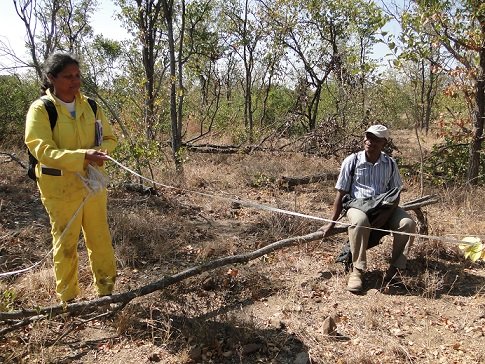|
Cycle 8 (2019 Deadline)
Understanding interactions between people, elephants and fires in the miombo woodlands of Niassa National Reserve in support of biodiversity conservation action
PI: Natasha Ribeiro (joluci2000@yahoo.com), Eduardo Mondlane University
U.S. Partner: Fernando Sedano, University of Maryland, College Park
Project Dates: November 2019 - February 2022
Project Overview
 | | The team conducts fieldwork at the reserve (photo courtesy of Dr. Ribeiro). |
The Miombo woodlands are the most extensive ecosystem in southern Africa, representing an important repository of biodiversity and providing critical goods and services for about 80% of both rural and urban populations in the area. Their ecology is largely determined by a combination of soils, climate, and disturbances, such as fire and herbivory by elephants. The Niassa National Reserve (NNR) is the largest protected area in Mozambique, supporting extensive Miombo woodlands and the largest elephant population in the country. About 60,000 people in the area depend on forest resources, relying on fire as a management tool.
This PEER project sought to improve our understanding about the interaction between people, fires, elephants, and habitat in the NNR in support of management actions to counteract the downward trend in elephant population due to poaching. The PI Dr. Ribeiro and her team integrated ground and aerial observations with multisensory and multitemporal remote sensing data to map, analyze, and characterize Miombo habitats for elephants. The mapping tool produced in this study will be made available to the reserve authorities to quickly assess changes in habitat distribution and quality and ultimately improve adaptive management actions.
Final Summary of Project Activities
The researchers developed maps of fire frequency and elephant distribution produced, modeling the spatial distribution of elephants based on habitat characteristics and human activities. The team showed that human activities (including fires) concentrated elephants in particular places. While the combination of fire and elephants produces a range of responses of the ecosystem, overall, the combination of high fire frequency and elephant density produces a more homogeneous woodland. The researchers found these effects were more prominent at the regeneration level, with a significant reduction in species abundance as a result of fires and elephants.
With their research, the PEER team contributed to the fire management plan at the NNR, including traditional knowledge on fires. One of the team members was hired to support fire management activities, and the project supported three Master’s and two PhD theses. The team also received a new grant from BIOFUND to extend their research to Gile National Park in Mozambique, as well as two additional grants for a total of $350,000.
Back to PEER Cycle 8 Grant Recipients
|
|
|
|




